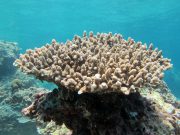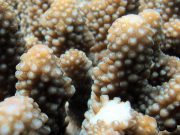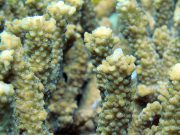Tauchen mit Hirschhornkorallen
Meeresleben von Lanta | Acroporidae
Die Familie Acroporidae, auch bekannt als 'Hirschhorn'- oder 'Verzweigungs'-Korallen, ist eine Familie von Steinkorallen, die Kolonien mit verzweigten Strukturen bilden, ähnlich wie ein Baum, ein Tisch oder ein Busch, wobei die Äste oder fingerähnlichen Wucherungen mit Tausenden von Korallenpolypen bedeckt sind.
Viele Arten von Hirschhornkorallen sind beim Tauchen von Koh Lanta aus zu sehen.
Diese schnell wachsenden Korallenäste sind in der Regel von kleinen Korallenpolypen umgeben, die als Radialkoralliten bekannt sind, und an der Spitze befindet sich ein markanter Axialpolyp, der normalerweise größer ist als die Radialpolypen.
Acropora-Korallen gibt es in vielen Formen und Größen und können in Farbe und Form sehr variabel sein, sogar innerhalb derselben Art.



Es können riesige Kolonien gebildet werden, und viele Arten sind sehr wichtige Riffbildner. Die Farben und die Bildung von Kolonien können von den Wachstumsbedingungen der Koralle, der Tiefe, der Klarheit des Wassers, den Strömungen usw. abhängen.
Die Kolonien können verzweigt, tischförmig oder in einigen Fällen verkrustet sein und sind an allen Tauchplätzen um Koh Lanta zu finden.
Die Identifizierung von Hirschhornkorallen ist schwierig und erfordert entweder eine genaue Untersuchung der Koralliten oder in extremen Fällen sogar eine biochemische und genetische Analyse.
Neue Kolonien entstehen, wenn Zweige abbrechen und sich wieder mit dem Substrat verbinden, was als ungeschlechtliche Fortpflanzung bezeichnet wird. Die geschlechtliche Fortpflanzung (Laichen) findet bei Acropora-Korallen ein- bis zweimal im Jahr bei Vollmond statt, wobei die Laichmonate je nach Art und Standort variieren.
Weitere Informationen finden Sie hier http://www.coralsoftheworld.org/page/home/
6 Arten auf dieser Seite gefunden:
- Acropora Austera Branching Coral (Acropora austera)
- Acropora Granulosa Table Coral (Acropora granulosa)
- Acropora Hyacinthus Table Coral (Acropora hyacinthus)
- Acropora Humilis Branching Coral (Acropora humilis)
- Acropora Secale Branching Coral (Acropora secale)
- Acropora Korusini Table Coral (Acropora korusini)
Acropora Austera Branching Coral
(Acropora austera)
This species forms colonies of very different shapes, from arborescent (tree-like) to very dense bushes/thickets. Branches vary in length, can be long, disorderly and partially fused. Sub branches are short, tapered and very abundant.

Acropora austera @ Koh Haa
The axial corallites are short, thick tubes with small openings. Radial corallites are sometimes arranged in rows, very close to each other, of different sizes and have thick walls with oblique, round or square openings.
Radial corallites vary from immersed to appressed, making the branches appear ragged.

Acropora austera @ Koh Haa
Acropora Granulosa Table Coral
(Acropora granulosa)
This table-like species in generally uncommon and grows in semi-circular horizontal plates, usually less than 1 m in diameter. The main branches are usually straight and horizontal, with the short secondary branches curving upward and equidistant to each other.

Acropora granulosa @ Hin Bida
Each secondary branch or branchlet is formed by a group of axial corallites and developing axial corallites, or only a single, large axial corallite which is long, think and swollen with a relatively small opening.
The axial corallite tip may be tapered or blunt. The radial corallites are tubular, small and appressed (their wall is directly attached to the branch from which they grow)

Acropora granulosa @ Hin Bida
Acropora Hyacinthus Table Coral
(Acropora hyacinthus)
This species forms wide flat table-shaped colonies and tiered aggregations of small plates with short branches that curve upwards in an orderly way. The central branches are usually fused.

Acropora hyacinthus @ Koh Haa
The axial corallites are tubular, rounded and slightly prominent. The radial corallites form rosettes, with the coralite wall attached to the branch from which it grows. Radial coralites are next to each other, and of the same size.
Acropora Humilis Branching Coral
(Acropora humilis)
This species forms digitate colonies with a broad, encrusting base Branches are thick, finger-like, gradually tapering to large dome-shaped axial corallites. This coral species can be cream, green, purple or blue.

Acropora humilis @ Koh Bida
The radial corallites are of two sizes, the larger are usually tubular, with thick walls and have oblique to nariform openings.
The smaller radial corallites are tubular apressed with a less developed outer wall and nariform opening.

Acropora humilis @ Koh Bida
Acropora Secale Branching Coral
(Acropora secale)
This species forms corymbose bushy colonies with thick tapered branches which are finger-like. Colonies are colourful, usually mixtures of cream, blue, purple, brown and yellow, commonly with purple branch ends and cream corallites.

Acropora secale @ Koh Bida
The axial corallites are tubular, small and have a relatively wide edge. The radial corallites are of mixed sizes, some are long tubes with round opening, others appressed (part of their wall is attached to the branch from which they stem).
The radial corallites are large and conspicuous, and some are quite long. Branches can look ragged or rough.

Acropora secale @ Koh Bida
Acropora Korusini Table Coral
(Acropora korusini)
This species forms corymbose colonies that can form a table-like structure with vertical branches. Branches along the outer edges are more horizontal than those in the center. The colony has a generally disorderly layout.

Acropora korusini @ Koh Bida
The axial corallites are tubular or slightly cone shaped, small and prominent. The radial corallites are lip-like/nariform with a swollen outer wall.
Some radial corallites may be slightly hooked and some may face in different directions. Radial corallites are next to each other and may be a mix of both large and small sizes.

Acropora korusini @ Koh Bida
Tauchen mit Hirschhornkorallen rund um Koh Lanta
Tauch- und Schnorchelausflüge
Wenn Sie gerne die Gelegenheit hätten, Hirschhornkorallen auf einem unserer täglichen Tauchausflüge während der Hochsaison von Koh Lanta aus zu sehen, dann senden Sie uns eine E-Mail an info@diveandrelax.com.
Nehmen Sie an unseren Speedboot-Tauchausflügen in der Hochsaison zu einigen der besten Tauchplätze Thailands teil und genießen Sie kleine Gruppen, kurze Fahrzeiten und einen Fokus auf hervorragenden persönlichen Service, Sicherheit und Spaß.
Noch kein zertifizierter Taucher? Lernen Sie auf Koh Lanta das Tauchen mit dem 3-tägigen SSI Open Water Diver Kurs.
Buchen Sie online und sparen Sie 10% auf Tauchausflüge und Tauchkurse auf Koh Lanta.
Weitere Informationen
Indo-Pazifische Meereslebewesen-Führer
- Allen, G., Steene, R., Humann, P., DeLoach, N. (2003) Reef Fish Identification, Tropical Pacific. Jacksonville, FL., USA: New World Publications, Inc., ISBN 1-878348-36-1.
- Humann, P., DeLoach, N., (2010) Reef Creature Identification, Tropical Pacific. Jacksonville, FL., USA: New World Publications Inc., ISBN 978-1-878348-44-9
- Debelius, H. (2013) Indian Ocean Reef Guide. Frankfurt, Germany: IKAN - Unterwasserarchiv, ISBN 978-3-939767-52-7.
- Debelius, H. (2004) Nudibranchs and Sea Snails, Indo-Pacific Field Guide. Frankfurt, Germany: IKAN - Unterwasserarchiv, ISBN 3-925919-51-1
- Erhardt, H., Knop, D. (2015) Corals Indo-Pacific Field Guide. Frankfurt, Germany: IKAN - Unterwasserarchiv, ISBN 3-925919-69-4.
- Veron J.E.N., Stafford-Smith M.G., Turak E. and DeVantier L.M. (2016). Corals of the World
Weitere Referenzen zu Meereslebewesen und weitere Informationen





